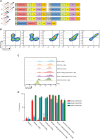Defining an Optimal Dual-Targeted CAR T-cell Therapy Approach Simultaneously Targeting BCMA and GPRC5D to Prevent BCMA Escape-Driven Relapse in Multiple Myeloma
- PMID: 33089218
- PMCID: PMC7575057
- DOI: 10.1158/2643-3230.BCD-20-0020
Defining an Optimal Dual-Targeted CAR T-cell Therapy Approach Simultaneously Targeting BCMA and GPRC5D to Prevent BCMA Escape-Driven Relapse in Multiple Myeloma
Erratum in
-
Correction: Defining an Optimal Dual-Targeted CAR T-cell Therapy Approach Simultaneously Targeting BCMA and GPRC5D to Prevent BCMA Escape-Driven Relapse in Multiple Myeloma.Blood Cancer Discov. 2024 Mar 1;5(2):132. doi: 10.1158/2643-3230.BCD-24-0017. Blood Cancer Discov. 2024. PMID: 38426409 Free PMC article. No abstract available.
Abstract
CAR T-cell therapy for multiple myeloma (MM) targeting B-cell maturation antigen (TNFRSF17; BCMA) induces high overall response rates; however, relapse occurs commonly. Implicated in relapse is a reservoir of MM if cells lacking sufficient BCMA surface expression (antigen escape). We demonstrate that simultaneous targeting of an additional antigen-here, G protein-coupled receptor class-C group-5 member-D (GPRC5D)-can prevent BCMA escape-mediated relapse in a model of MM. To identify an optimal approach, we compare subtherapeutic doses of different forms of dual-targeted cellular therapy. These include (1) parallel-produced and pooled mono-targeted CAR T-cells, (2) bicistronic constructs expressing distinct CARs from a single vector, and (3) a dual-scFv "single-stalk" CAR design. When targeting BCMA-negative disease, bicistronic and pooled approaches had the highest efficacy, whereas for dual-antigen-expressing disease, the bicistronic approach was more efficacious than the pooled approach. Mechanistically, expressing two CARs on a single cell enhanced the strength of CAR T-cell/target cell interactions.
Keywords: adoptive cellular therapy; antigen escape; chimeric antigen receptor; immunotherapy; multiple myeloma.
Conflict of interest statement
C. Fernández de Larrea is an employee/paid consultant for Bristol Myers Squibb, Takeda Oncology, Janssen, and Amgen, and reports receiving speaker's bureau honoraria from Bristol Myers Squibb, Janssen and Amgen. Y. Chen is an advisory board member for and reports receiving research commercial grants from Amgen, and reports receiving speaker's bureau honoraria from Bristol Myers Squibb, Janssen, and Takeda Oncology. R.J. Brentjens is an employee/paid consultant for JUNO Therapeutics, and Gracell Biotherapeutics Inc., and reports receiving research commercial grants from JUNO Therapeutics, and holds ownership interests (including patents) in JUNO Therapeutics. E.L. Smith is an employee/paid consultant for Bristol, Myers Squibb, Fate Therapeutics, and Precision Biosciences, reports receiving research commercial grants from Bristol Myers Squibb, and receiving other receiving other remuneration from Bristol Myers Squibb. No potential conflicts of interest were disclosed by the other authors.
Figures




Comment in
-
Dual Targeting with CAR T Cells to Limit Antigen Escape in Multiple Myeloma.Blood Cancer Discov. 2020 Aug 3;1(2):130-133. doi: 10.1158/2643-3230.BCD-20-0122. eCollection 2020 Sep. Blood Cancer Discov. 2020. PMID: 34661143 Free PMC article.
Similar articles
-
GPRC5D is a target for the immunotherapy of multiple myeloma with rationally designed CAR T cells.Sci Transl Med. 2019 Mar 27;11(485):eaau7746. doi: 10.1126/scitranslmed.aau7746. Sci Transl Med. 2019. PMID: 30918115 Free PMC article.
-
Efficacy and safety of chimeric antigen receptor T cells targeting BCMA and GPRC5D in relapsed or refractory multiple myeloma.Front Immunol. 2024 Dec 23;15:1466443. doi: 10.3389/fimmu.2024.1466443. eCollection 2024. Front Immunol. 2024. PMID: 39763668 Free PMC article.
-
Mechanisms of antigen escape from BCMA- or GPRC5D-targeted immunotherapies in multiple myeloma.Nat Med. 2023 Sep;29(9):2295-2306. doi: 10.1038/s41591-023-02491-5. Epub 2023 Aug 31. Nat Med. 2023. PMID: 37653344 Free PMC article.
-
GPRC5D-Targeted CAR T Cells for Myeloma.N Engl J Med. 2022 Sep 29;387(13):1196-1206. doi: 10.1056/NEJMoa2209900. N Engl J Med. 2022. PMID: 36170501 Free PMC article. Clinical Trial.
-
Beyond BCMA, why GPRC5D could be the right way: treatment strategies with immunotherapy at relapse after anti-BCMA agents.Cancer Immunol Immunother. 2023 Dec;72(12):3931-3937. doi: 10.1007/s00262-023-03559-4. Epub 2023 Nov 4. Cancer Immunol Immunother. 2023. PMID: 37924369 Free PMC article. Review.
Cited by
-
Multiple myeloma: signaling pathways and targeted therapy.Mol Biomed. 2024 Jul 4;5(1):25. doi: 10.1186/s43556-024-00188-w. Mol Biomed. 2024. PMID: 38961036 Free PMC article. Review.
-
CAR T therapies in multiple myeloma: unleashing the future.Cancer Gene Ther. 2024 May;31(5):667-686. doi: 10.1038/s41417-024-00750-2. Epub 2024 Mar 4. Cancer Gene Ther. 2024. PMID: 38438559 Free PMC article. Review.
-
From spear to trident: Upgrading arsenal of CAR-T cells in the treatment of multiple myeloma.Heliyon. 2024 Apr 21;10(9):e29997. doi: 10.1016/j.heliyon.2024.e29997. eCollection 2024 May 15. Heliyon. 2024. PMID: 38699030 Free PMC article. Review.
-
ISB 2001 trispecific T cell engager shows strong tumor cytotoxicity and overcomes immune escape mechanisms of multiple myeloma cells.Nat Cancer. 2024 Oct;5(10):1494-1514. doi: 10.1038/s43018-024-00821-1. Epub 2024 Sep 11. Nat Cancer. 2024. PMID: 39261676 Free PMC article.
-
Targeting BCMA in multiple myeloma: designs, challenges, and future directions.Cancer Immunol Immunother. 2025 Feb 1;74(3):77. doi: 10.1007/s00262-024-03913-0. Cancer Immunol Immunother. 2025. PMID: 39891674 Free PMC article. Review.
References
-
- Bergsagel PL. Where we were, where we are, where we are going: progress in multiple myeloma. Am Soc Clin Oncol Educ Book 2014;34:199–203. - PubMed
-
- Bladé J, Rosiñol L, Fernández de Larrea C. How I treat relapsed myeloma. Blood 2015;125:1532–40. - PubMed
-
- Ghobrial I, Cruz CH, Garfall A, Shah N, Munshi N, Kaufman Jet al. . Immunotherapy in multiple myeloma: accelerating on the path to the patient. Clin Lymphoma Myeloma Leuk 2019;19:332–44. - PubMed
Publication types
MeSH terms
Substances
Grants and funding
LinkOut - more resources
Full Text Sources
Other Literature Sources
Medical
Research Materials

